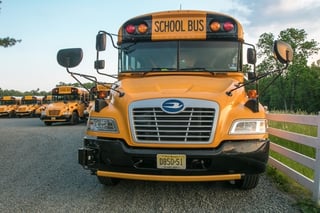School Bus Fleet Department Overhaul: Five Areas To Consider
published on January 16, 2018 by Sonia Mastros
 School transportation budgets are often tight, and that can make proper school bus fleet development a real challenge. It becomes easy – perhaps unavoidable – to look at fleet development in terms of small ad-hoc changes as budget allows, without much planning for the future.
School transportation budgets are often tight, and that can make proper school bus fleet development a real challenge. It becomes easy – perhaps unavoidable – to look at fleet development in terms of small ad-hoc changes as budget allows, without much planning for the future.
Of course, those tactics can also backfire over time, particularly if they are holding your district back from realizing much better solutions that would be safer, easier, or more cost-effective. Sometimes, a more major overhaul is needed for long-run improvements.
Is your transportation system falling behind in key areas? It could be time for an overhaul.
Five Areas Where a School Bus Fleet Development Overhaul Might Be Needed
1 - Bus engines
There are still a lot of buses on the road today using old-style diesel engines, which are both inefficient and heavy polluters. Running them costs money, as well as directly exposing families to dangerous pollutants. Luckily, the EPA provides a rebate program aimed at helping schools afford to move towards newer, cleaner, more fuel-efficient engines. Check out the deadlines to be sure you apply in time for the 2018-2019 school year.
2 - Fuel procurement
Some districts are finding they can substantially cut costs by cutting new deals for fuel, or even installing pump facilities on their grounds so they can buy in bulk. This is a particularly attractive option for schools looking at alternative-fuel engines, such as propane or compressed natural gas.
3 - Driver training
How much time are you spending on the development of your drivers? There are a number of topics, such as defensive driving and multicultural awareness, which can significantly improve their on-road performance if your training program gets an overhaul.
4 - Student safety features
There have been many revolutions in student safety in recent years, with technologies such as video surveillance and RFID tracking, which makes it easier to ensure safe ridership and good behavior while onboard. Districts are also reconsidering the long-held belief that seat belts on buses aren’t worth the investment. If there’s one area that's always worth spending extra money on, it’s student safety.
5 - Route planning
Modern computer systems can calculate bus routes far more quickly, accurately, and optimally than humans. In terms of a single investment that could overhaul a district’s transportation system, this could be one of the best. Route planning systems can greatly reduce fuel use, or potentially even cut one or more buses from daily routes entirely. That doesn’t just save money, it also means needing fewer drivers.
How is school bus fleet development handled in your district? Are you given enough agency to make smart plans for the future? Let’s talk about it in the comments below.
Image Editorial credit: / Shutterstock.com



